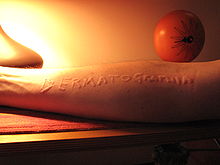- Dermatographic urticaria
-
Dermatographic urticaria Classification and external resources 
Dermatographic urticaria is sometimes called "skin writing".ICD-10 L50.3 ICD-9 708.3 OMIM 125635 DiseasesDB 12736 eMedicine derm/446 Dermatographic urticaria (also known as dermographism, dermatographism or "skin writing") is a skin disorder seen in 4–5% of the population and is one of the most common types of urticaria,[1] in which the skin becomes raised and inflamed when stroked, scratched, rubbed, and sometimes even slapped.[2]
Contents
Presentation
The symptoms are thought to be caused by mast cells in the surface of the skin releasing histamines without the presence of antigens, due to the presence of a weak membrane surrounding the mast cells. The histamines released cause the skin to swell in the affected areas.
This weak membrane easily and rapidly breaks down under physical pressure causing an allergic-like reaction, in general a red wheal (welt) to appear on the skin. It can often be confused with an allergic reaction to the object causing a scratch, when in fact it is the act of being scratched that causes a wheal to appear. These wheals are a subset of urticaria (hives) that appear within minutes, accompanied by a sensation of burning, and itchiness. The first outbreak of urticaria can lead to others on body parts not directly stimulated, scraped, or scratched. In a normal case, the swelling will reduce itself with no treatment within 15–30 minutes, but, in extreme cases, itchy red weals may last anywhere from a few hours to days.
It has been reported that one artist with dermatographism, Ariana Page Russell, uses her skin as her artistic medium.[3]
Causes
The underlying cause of dermographism is not known, and can last for many years without relief. Ninety-five percent of chronic cases are never solved. Sometimes the condition goes away, sometimes it stays forever. It is not a life-threatening disease and is not contagious (transferable to other persons).
Symptoms can be induced by stress, tight or abrasive clothing, watches, glasses, heat, cold,[4] or anything that causes stress to the skin or the patient. In many cases, it is merely a minor annoyance, but in some rare cases symptoms are severe enough to impact a patient's life.
Treatment
Dermographism can be treated by antihistamines, which prevent histamine from causing the reaction. These may need to be given as a combination of H1 antagonists, or possibly with an H2-receptor antagonist such as cimetidine.[5][6]
Not taking hot baths or showers may help if it is generalized (all over) and possibly for localized (in a specific area). If not taking showers helps, it may be a condition called shower eczema. If it affects mainly the head, it may be psoriasis. In rare cases, allergy tests may uncover substances the patient is allergic to. Using biodegradable or hypo-allergenic soaps and laundry supplies may help.
While cromoglycate, which prevents histamine from being released from mast cells, is used topically in rhinitis and asthma, it is not effective orally for treating chronic urticaria.[7][8]
Acupuncture and Chinese herbs have long been used to treat urticaria in the Asian world. Results of clinical trials of both acupuncture and Chinese herbs are inconclusive and are possibly a result of the placebo effect, as the trials did not involve a control group.[9][10][11]
See also
- Triple response of Lewis
- List of cutaneous conditions
References
- ^ Jedele KB, Michels VV (1991). "Familial dermographism". Am. J. Med. Genet. 39 (2): 201–3. doi:10.1002/ajmg.1320390216. PMID 2063925. http://www3.interscience.wiley.com/cgi-bin/fulltext/110516063/PDFSTART.
- ^ Kontou-Fili K, Borici-Mazi R, Kapp A, Matjevic LJ, Mitchel FB (1997). "Physical urticaria: classification and diagnostic guidelines. An EAACI position paper". Allergy 52 (5): 504–13. doi:10.1111/j.1398-9995.1997.tb02593.x. PMID 9201361.
- ^ Hunte, Tracie (March 14, 2008). "Artist: 'I Use My Skin as a Canvas'". ABC News. http://abcnews.go.com/Health/story?id=4446929. Retrieved 2008-10-05.
- ^ Kaplan AP (1984). "Unusual cold-induced disorders: cold-dependent dermatographism and systemic cold urticaria". J Allergy Clin Immunol 73 (4): 453–6. doi:10.1016/0091-6749(84)90354-3. PMID 6200525.
- ^ Wozel G, Sahre EM, Barth J (1990). "[Effectiveness of combination treatment with H1-(Tavegyl) and H2-antagonists (Altramet) in chronic/chronically-recurrent urticaria]" (in German). Dermatologische Monatschrift 176 (11): 653–9. PMID 2083605.
- ^ Negro-Alvarez JM, Miralles-López JC (2001). "Chronic idiopathic urticaria treatment" ([dead link] – Scholar search). Allergologia et immunopathologia 29 (4): 129–32. PMID 11674926. http://db.doyma.es/cgi-bin/wdbcgi.exe/doyma/mrevista.pubmed_full?inctrl=05ZI0102&rev=105&vol=29&num=4&pag=129.
- ^ Thormann J, Laurberg G, Zachariae H (March 1980). "Oral sodium cromoglycate in chronic urticaria". Allergy 35 (2): 139–41. doi:10.1111/j.1398-9995.1980.tb01728.x. PMID 6770707.
- ^ Soter NA (December 1990). "Urticaria: current therapy". The Journal of allergy and clinical immunology 86 (6 Pt 2): 1009–14. doi:10.1016/S0091-6749(05)80245-3. PMID 1979795.
- ^ Jianli Che (2006). "The Effect of Acupuncture on Serum IgE Level in Patients with Chronic Urticaria". Journal of Traditional Chinese Medicine 26 (3): 189–190. PMID 17078446. http://d.wanfangdata.com.cn/Periodical_zyzz-e200603012.aspx.
- ^ Chung-Jen Chen MD, Hsin-Su Yu MD PhD (1998). "Acupuncture Treatment of Urticaria". Archives of Dermatolology 134 (11): 1397–1399. doi:10.1001/archderm.134.11.1397. PMID 9828874. http://archderm.ama-assn.org/cgi/content/abstract/134/11/1397.
- ^ Benjamin Kligler, Roberta A. Lee (April 2004). Integrative medicine: principles for practice. 134. McGraw-Hill Professional. pp. 371–377. ISBN 9780071402392. http://books.google.com/?id=-JUcjUGBV6kC.
Urticaria and erythema (L50–L54, 695, 708) Urticaria
(acute/chronic)Allergic urticariaUrticarial allergic eruptionPhysical urticariaCold urticaria (Familial) · Primary cold contact urticaria · Secondary cold contact urticaria · Reflex cold urticariaDermatographic urticariaAquagenic urticariaOther urticariaAcquired C1 esterase inhibitor deficiency · Adrenergic urticaria · Exercise urticaria · Galvanic urticaria · Schnitzler syndrome · Urticaria-like follicular mucinosisErythema Erythema multiforme minor · Erythema multiforme major (Stevens–Johnson syndrome, Toxic epidermal necrolysis) · panniculitis (Erythema nodosum) · Acute generalized exanthematous pustulosisFigurate erythemaOther erythemaNecrolytic migratory erythema · Erythema toxicum · Erythroderma · Palmar erythema · Generalized erythemaCategories:- Urticaria and angioedema
Wikimedia Foundation. 2010.

